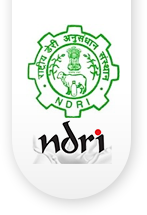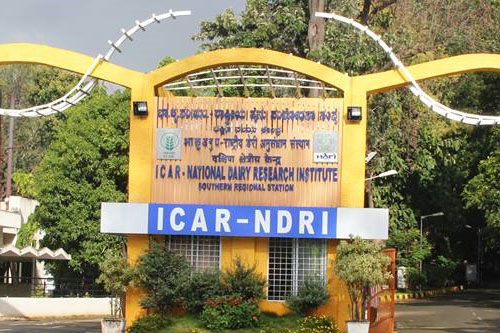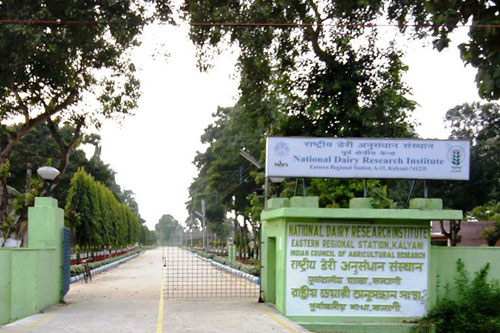NDRI Links
- About NDRI
- Research & Development
- Education
- Division
- Regional Station
- Administration
- NDRI Library
- Publication
- Services
- Extension
- Facilities
- Former Directors
- Progressive Farmers
- Staff Club
- Downloads
- Technologies & Patents
- Photo Gallery
- Auditorium
- Job Opportunities
- Hindi Prakashan
- Circulars
- E-books
- Information for Ranking of Agricultural Universities – 2018
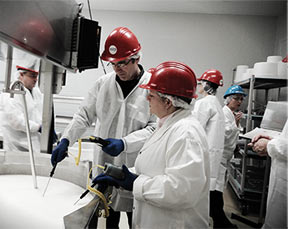
Divisions / Sections
KNOW moreSouthern Regional Station, Bengaluru
About – Southern Regional Station,Bangaluru
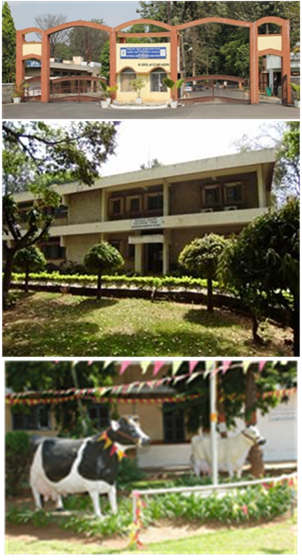
Southern Regional Station of National Dairy Research Institute is the pioneering institution in Dairying and has undergone a series of changes during its history of more than eighty seven years. It had its origin on 16th July 1923 as Imperial Institute of Animal Husbandry and Dairying, established as a centre for training and research in dairying in the country. This centre was the first to initiate training in artificial insemination in cattle in the country and also research in different fields of dairy production and processing in India. A two year course leading to Indian Dairy Diploma (IDD) was started as back as in 1923 and it is a matter of pride that the Alumni of the Institute served at various capacities for the development of dairy sector in the country. One of the memorable events of the Imperial Institute was the visit of Mahatma Gandhi in 1927 who got acquainted with scientific dairy farming. After independence, Imperial Dairy Research Institute was renamed as Indian Dairy Research Institute. The activities of the institute were further strengthened during 1952-54 by locating a Central Artificial Insemination Centre, Key Village Scheme and Southern Regional Animal Nutritional Research Centre at Bangalore. Indian Dairy Research Institute was reorganized in 1955 and renamed as National Dairy Research Institute with headquarters at Karnal. The establishment at Bangalore was redesignated as Southern Regional Station of NDRI. The Campus is endowed with necessary infrastructure in terms of qualified staff, having 160 employees, including about 21 Scientists, farmland of about 21 ha, dairy herd of about 250 animals comprising Deoni, Malnad Gidda cattle & HF Crossbred cattle, laboratories, experimental dairy plant, library, staff dispensary, and students hostel & guest house facilities. The Station functions with following Mandates & Objectives focused on the region issues.
Mandate
- Identify the region specific problems of dairy production, processing and management on continuing basis and evolve suitable solutions.
- Establish centers for technology development, assessment and dissemination.
- Establish centers of advanced studies for R & D and HRD with the Station as the Southern Campus of NDRI Deemed University.
Objectives
- Faster multiplication of superior germplasm of region specific breeds of cattle and buffaloes through interventions.
- Process upgradation for the industrial production / packaging of region specific dairy products.
- Establishment of the regional referral centre for quality assurance of dairy products.
- Economic analysis of various aspects of dairying and establishment of data bank for strategic development of dairying in the region.
- Establishment of model villages with integrated development focused on dairying.
- Transfer of technologies suitable for the crop-livestock production systems prevalent in agro-climatic conditions of the region.
- Training of farmers and industrial entrepreneurs at technology development centers.
- Undertake advanced HRD programmes to meet the needs of the industry.
Recent Research and Extension Achievements
The station pioneered the activities in respect of artificial insemination in the country. Simple and reliable test (Motility Index) for evaluating semen was developed. Introduction of 10-ml. taurine buffers in the genital tract immediately before AI, found to improve conception in cattle. The Nutritional survey of dairy cattle carried out by the station in Southern India was perhaps one of the earliest works in animal nutrition and the study brought out the feeding practices and deficiency of minerals in cattle ration. The research finding of feeding of urea ammoniated paddy straw to milch animals resulted in significant (20%) increase in milk yield and 20% reduction in cost of milk production by way of reduction of concentrate requirement. Under the Key Village Scheme, Key Farm Centres were established for facilitating primary activities and providing veterinary health care. Calibration of lactometer lead to a great help to dairy industry. Simple and rapid electrometric method for estimation of SNF was developed. Methods were developed to detect adulteration of ghee with Vanaspathi and Vegetable Oil. Bacteriological standards were suggested for grading of milk and quality evaluation of pasteurized milk. A sediment chart was developed to assess the dirt content in milk. Successfully developed and modified the methodologies for manufacture of dairy products viz., fruit flavored high fat yoghurt, low cost cream spread, kadhi power, cholesterol free mozzarella cheese and basundi. An easy to constitute dry mix was developed for ‘Palada Payasam’. Extensive studies on cost of milk production and constraint analysis of dairy farming were carried out.
- The Malnad Gidda is unique dwarf cattle which mostly thrive on grazing and play a unique role in the farming systems of the heavy rain fall Malnad and coastal regions of Karnataka. Good number of cows calved more than 15 calves in their life time. The lactoferrin content in Malnad Gidda cattle milk was found to be higher (range 48.98 to 157.10µg/ml). The breed was got registered as a distinct indigenous breed of Karnataka.
- The studies on the frequency of A1 and A2 casein allele in Malnad Gidda, Deoni, HF cattle and HF graded cattle indicated that A2 allele is fixed in Deoni cattle while the frequency of A1 allele among graded HF cattle was 0.3. Among Malnad Gidda cattle except 3 cows from one herd all the 154 cows screened were of A2A2 type.
- Efforts were made for the on the spot diagnosis and control mastitis especially subclinical mastitis through testing of milk by electrical conductivity meter, assessing somatic cell counts by California Mastitis Test (CMT) and automated digital reader.
- Demonstration cum training programmes relating to sub-clinical mastitis were arranged for around 1000 farmers of Bangalore and Kolar districts and the programme made tremendous impact on dairy farmers and dairy co-operative societies.
- A total of fifteen commercial dairy farms maintaining graded Holstein Friesians located around Ludhiana, Moga, Mohali and Chandigarh were visited and personal interviews with the farmers were conducted. The intensive management inputs coupled with expert advice are resulting in good conception rate, regular calving, and healthy growth of young stock and higher yields.
- It is suggested to establish feed mixing units in border districts of Tamil Nadu/ Karnataka and import ready mix feed. All water logging lands in Kerala can be converted into ‘Para Grass fields’ thus improving fodder availability. Further, there is strong reason to promote dairy farming in high altitude regions like, Palakkad, Wyanad & Idukki.
- Using homogenous fermentation kinetics of heterogenous feedstuffs, concentrate supplements were formulated to cater the intensity of fermentation to support different levels of milk production.
- An attempt was made to develop a dry mix using popped ragi and milk solids. Channa Jhilli prepared according to the standardized procedure was evaluated for its shelf life.
- Technology for preservation of Kunda and Chhana Podo by EVOH & PET multiplayer high barrier packaging material coupled with oxygen scavenger was developed. The product thus packed can be kept well without spoilage over 45 days in case of Chhana Podo & more than 180 days in case of Kunda.
- A method for the preparation of ready to reconstitute payasam dry mix incorporating ground green gram dhal and poppy seeds and skim milk powder was standardized.
- Whey drink was prepared from both protein and lactose hydrolyzed whey with 8% sugar, 1% starch and 4% mango pulp which was acceptable for the consumers. Thermization of whey drinks at 650C for 10 min has shown an increased shelf life of the product.
- For the preparation of sugarless khoa jalebi, non-conventional sweeteners and bulk sweeteners were tried in place of sucrose. Using combination of these sweeteners, a sweetened syrup has been formulated for the preparation of sugarless khoa jalebi.
- Extracts of some of the vegetables and fruits were used in the preparation of buttermilk drinks for enhanced health benefits.. An attempt was made to improve the textural stability of buttermilk drinks through homogenization of the milk used and addition of stabilizers. Thermization and carbonation of buttermilk drinks helped to extend the shelf-life of the buttermilk drinks.
- Paneer was coated with casein, whey protein concentrate and tapioca starch coatings and dried. Paneer coated with starch and casein stored well and was of similar quality. Therefore, edible coatings can be recommended for paneer for extension of its shelf life.
- Orange peel having antioxidants activities could be used as a cheap natural source of natural antioxidants which can be used in fat rich dairy products like ghee for retarding oxidative deterioration
- The Techno-economic study conducted indicated that the two technologies transferred namely, gulam jamoon mix & palada payasam mix are doing well at KMF and MILMA respectively and enabled the Federations to add new product to their product mix, besides realizing higher revenue
- Economic analysis of manufacture of selected dairy products in the organized dairies from Southern states indicated that cost of production of dairy products varied across the dairies. It was also found that the dairies had created good infrastructure and provided services for the development of the dairy farmers.
- The role of government organizations is analyzed in terms of functions, financial support, programme organized and capacity building activities for entrepreneurial development of rural women and in terms of entrepreneurial initiatives, facilitation, support and sustenance
- The milk products used in the traditional systems, Ayurveda, Unani, Siddha and homeopathy include curd, buttermilk, butter, ghee, cream, whey and paneer. Milk and milk products play an important and inevitable role in all the three traditional medicinal systems.
- The profile study on small holder dairy production systems in the southern region indicated that majority of the respondents possessed 2-5 dairy animals (64-76%). The cost of milk production in the region ranged from Rs.17-23/litre. It was revealing that dairy farmers are facing umpteen constraints that arrest dairy development and need to be redressed on priority.
- The dairy entrepreneurship development of two Self Help Group members involved in dairy farming were studied and entrepreneurship trainings were imparted to study the impact on their livelihood.
- On-farm and off-farm Training programmes were arranged for dairy entrepreneurs/dairy farmers for hand on training programme for its future application towards control of subclinical and clinical mastitis
- The extension section was involved in conducting visitors to the institutes, providing advisory services, conducting orientation and training programmes and distribution of extension literature prepared in local languages for the benefit of farmers.
- Extension section is also involved in conducting various training programmes & participation in different Exhibition.
On-Going Research and Extension Activities
- Evaluation of single nucleotide polymorphism in candidate genes associated with semen quality in murrah buffaloes and khillar cattle
- Investigation on QTL and non genetic factors regulating postpartum productive and reproductive performances in Deoni cattle
- Studies on reproductive performance and fertility augmentation in Deoni cattle
- Investigation on factors affecting semen quality and freezability in Deoni and Malnad Gidda cattle
- Incorporation of inulin and resistant starch in cheddar cheese to enhance functional attributes
- Utilisation of lactose hydrolysed whey in the preparation of probiotic fermented beverages
- Post processing interventions to improve quality and shelf-life of curd rice
- Design and development of microprocessor based automated instrumentation system for pneumatic paneer hoop cum-press unit.
- Analysis of energy and exergetic performance of spray drying system for milk-malted millet food.
- Development of khoa jalebi using non-conventional sweetners
- Extension of shelf-life of ghee using extracts of fruits and vegetable by products
- Isolation and identification of bacteriophages from dairy products and environment and evaluation of starter culture for the phage resistance
- Dairy entrepreneurship development of rural women: An action research
- Geospatial databank and data mining for strategic planning and development of dairying in Karnataka state
- Evaluation and Improvement of indigenous cattle of Malnad Region of Karnataka
- As a new initiative at SRS, the ‘Dairy Education at Farmer’s Door’, was organized and visits were made by the multidisciplinary team on second Saturdays to villages in and around Bangalore districts. Necessary technical advice was rendered by the multidisciplinary team on various aspects of scientific dairy farming, green fodder production, clean milk production and dairy animal management aspects to the needy clientele group at their doorsteps.
- A new cluster of villages has been identified to implement Rural Extension Programme.
Education and Training
SRS of NDRI has been the pioneering institution in dairy education in the country. The Indian Dairy Diploma and subsequent educational and capacity building programmes greatly enabled the dairy industry in providing the right man power to meet the requirements of the industry. The educational activities of the station are being expanded to accommodate more students in future. A Post Graduate Programme in Food Quality and Safety Assurance was started in 2014 to meet the requirement of dairy industry. Course work for Diploma in Dairy Technology, M.Tech in Dairy Technology, Dairy Enginnering & Food Quality and Safety Assurance and Ph.D in Dairy Engineering are being offered at SRS , while students after completing the course work from NDRI Karnal report at SRS for pursuing their dissertation work in the disciplines of AGB,LPM, AN, DC & DB, D.Econ & D.Extn. The station has more than 100 students undergoing Diploma in Dairy Technology, Post Graduate & Doctoral Programmes in various disciplines of Dairy Science. The students are also enabled for placement for their potential employment through placement cell. Besides, the Station also runs a variety of tailor made training programmes of varying duration for the benefit of farmers and entrepreneurs. SRS organizes Model Training Course, ICAR Summer / Winter Schools and sponsored Training Programmes as part of capacity building endeavor.
Technologies Developed
- Hamster egg penetration bioassay for fertility assessment of bulls.
- Enhancement of buffalo sperm motility and fermentation of invitro natured oocytes by pentoxyfilline and heparine treatment.
- Calibration of lactometer
- Palada Payasam Mix , Gasa Gase payasam mix & Avalakki Payasam technologies
- Process manufacture of Kalan with extended shelf life Standardized
- Gulab Jamoon Mix technology
- Cheese Puri Mix technology
- Curd Rice technology
- Kunda Process manufacture standardized
- Khadi Powder technology
- Channa Podo technology
- Instant Palada Payasam Mix
- Basundi Process manufacture standardized
- Palada Payasam Mix technology transferred to MILMA, Kerala for commercial production.
- Gulab Jamoon Mix technology transferred to KMF, Bangalore for commercial production.
- Development of buttermilk with added health benefits and extended shelf-life.
Future Thrust on Research and Extension Activities
- Productivity enhancement and quality milk production from Indigenous cattle, buffaloes and crossbred cattle in the region through genetic, biotechnological, nutritional and managemental interventions
- Development of dairy foods with synbiotics, micronutrients & bioactive compounds.
- Adoption of emerging technologies , modeling & innovative packaging.
- Modernization of dairy education & capacity building
- Analysis of milk production systems , value chains, constraint analysis and Geo-Spatial data base on dairying.
- Development of model village for technology transfer activities and utilization of ICT.
Historical Photos
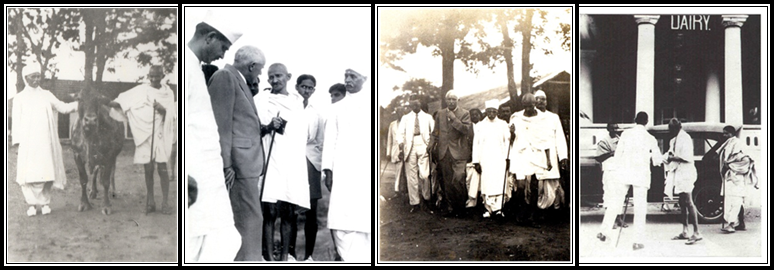
Events
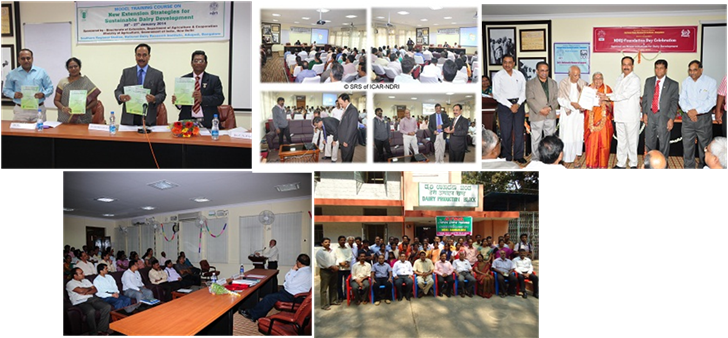
Extension Activities
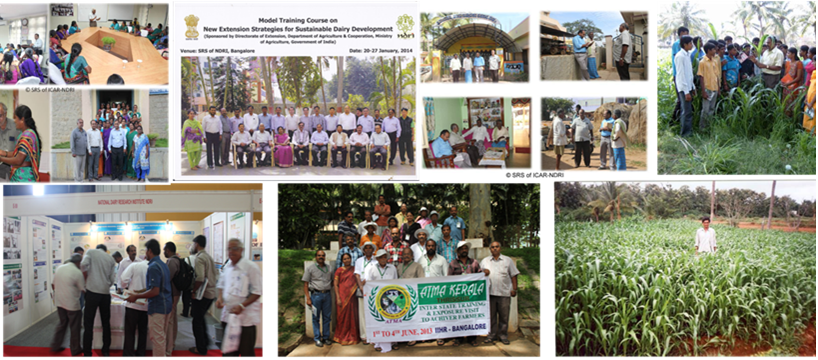
Facilities
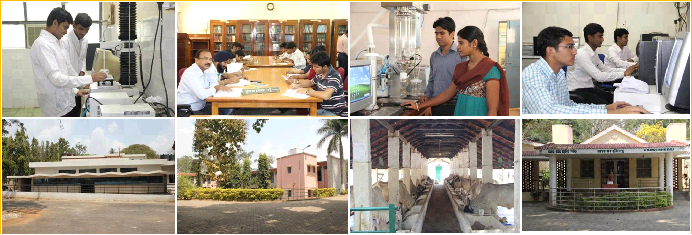
Faculty Profile
| Dr. K. P. Ramesha | Principal Scientist & Head |
| Dr. B. Surendranath | Principal Scientist |
| Dr. Satish Kulkarni | Principal Scientist |
| Dr. B.C. Ghosh | Principal Scientist |
| Dr. P.K. Dixit | Principal Scientist |
| Dr. B. Srinivas | Principal Scientist |
| Dr. K. Jayaraj Rao | Principal Scientist |
| Dr. D.N. Das | Principal Scientist |
| Dr. P. Heartwin Amaladhas | Principal Scientist |
| Dr. M. Sivaram | Principal Scientist |
| Dr. Menon Rekha Ravindra | Principal Scientist |
| Dr. M.C. Arunmozhi Devi | Senior Scientist |
| Dr. S. Jeyakumar | Senior Scientist |
| Er. F.Magdaline Emerald Eljeeva | Senior Scientist |
| Dr. Mukund A. Katakalware | Senior Scientist |
| Dr. A. Kumaresan | Senior Scientist |
| Dr. Manjunatha M | Scientist |
| Dr. S. Varalakshmi | Scientist |
| Dr. S. Subash | Scientist |
| Dr. A. Manimaran | Scientist |
| Dr. Laxmana Naik N | Scientist |
Eastern Regional Station, Kalyani
Historical Background

The Eastern Regional Station (ERS) of National Dairy Research Institute (NDRI) was established in February 1964 at the Central Dairy in Calcutta. In September, 1965; a herd of 95 Red Sindhi cattle were transferred from NDRI, Karnal to ERS. These animals were initially stationed at the State Livestock Farm, Kalyani; and were then shifted to the Milk Colony, Haringhata in the year 1966. The office of the ERS was also shifted from Calcutta to Kalyani during 1966 and was located in the Administrative Building of Kalyani University. Kalyani was then a small industrial town located at a distance of about 50 km north of Calcutta. After a year, it was shifted to the newly established Bidhan Chandra Krishi Viswavidyalaya premises at Kalyani. Laboratory facilities were gradually developed there. The Regional Animal Nutrition Research Centre of the ICAR till then located at Haringhata was also merged with the ERS of NDRI with effect from 1st June, 1968.
Research on various disciplines of dairying e.g. Dairy Chemistry, Dairy Bacteriology, Dairy Technology, Animal Nutrition, Dairy Economics and Extension were initiated. Crossbreeding of the indigenous stock with Holstein-Friesian bulls was started at around 1972. A Dairy Demonstration Unit was established for educating the farmers in scientific dairy farm management practices. An extensive exercise was also carried out to determine the nutritive value of tree leaves and field grasses of the eastern region.
In 1978, the Government of West Bengal allotted 100 acres of land for the eastern regional station in A-12 Block of Kalyani. Cattle shed, laboratory buildings and staff quarters etc. were gradually built up there. The unused barren land was developed in to a fodder farm to provide quality fodder to the high yielding crossbred cattle maintained at this centre. The main thrust was to evolve a high yielding genotype suitable to the warm-humid subtropical agro-climatic condition of eastern India. Induction of Karan-Fries and Jersey x Tharparkar crossbred cows to the cattle herd of ERS on transfer from NDRI, Karnal was an important step in this direction.
The development of infrastructure was nearly completed in May, 1987. The research activities started in full swing in the second half of 1987 from the new campus. The research work during the period of 1964-1972, was mainly related to Animal Nutrition, that during the period of 1972-1976, was related to Animal Nutrition, Dairy Chemistry, Dairy Bacteriology and Dairy Technology, that during the period of 1977-1985, was related to Animal Nutrition, Animal Breeding, Soil Science, Dairy Economics and Dairy Extension, that during the period of 1986-1991, were related to Animal Nutrition, Livestock Production and Management, Animal Breeding, Forage production, Dairy Economics and Statistics and Dairy Extension and that during the period of 1992-1997, were related to Animal Nutrition, Livestock Production and Management, Animal Breeding, Forage production, Dairy Economics and Statistics and Dairy Extension. Dairy Biotechnology section was established and started functioning since 2006-07. The regional station has effective infrastructure facilities like Dairy Farm, Fodder Farm, Library and Computer Unit to support research and extension activities
Milestones
| 1964 | Established in February 1964 at the Central Dairy in Calcutta. |
| 1965 | A herd of 95 Red Sindhi cattle were transferred to ERS from NDRI, Karnal |
| 1966 | The office of the ERS shifted from Calcutta to Administrative Building of Kalyani University. |
| 1967 | Shifted to newly established Bidhan Chandra Krishi Viswavidyalaya premises at Kalyani. |
| 1968 | The Regional Animal Nutrition Research Centre (ICAR), Haringhata, was merged with ERS |
| 1978 | The Govt. of W.B. allotted 100 acres of land for the ERS in A-12 Block of Kalyani. |
| 1979-86 | Infrastructure e.g.Cattle shed, Fodder farm Lab buildings, quarters etc were gradually built. |
| 1987 | The development of infrastructure was nearly completed in May, 1987. |
| 2002 | The new Administrative Block was built |
| 2006 | The Machine Milking facility has been introduced. |
| 2007 | Established Animal Biotechnology lab. |
| 2014 | Established Animal Physiology and Reproduction labDiploma in Animal Husbandry and Dairying started |
Location & Climate
Kalyani is situated at 22° 58’30″N Latitude and 88° 26′ 4″ E Longitude. Kalyani is located at the lower Gangetic basin of West Bengal in Nadia district, 48 km north from Kolkata and is well connected by rail and road. ERS is around 2 km away from the Kalyani railway station. The climatic condition is hot humid. The average annual maximum temperature is 320C and the minimum temperature is 200C. The maximum humidity is 91% and minimum humidity is 58%. The annual rainfall is around 1250 mm.
Objectives
- Identification of problems related to dairy production and management in eastern India
- Strategic and applied research for improvement of production, management and economic aspects of dairying under changing climatic condition in the region.
- Maintenance of superior germplasm for obtaining optimum productivity in dairy animals.
- Transfer of technology and awareness development through training, demonstration and extension services.
Organisation and Structure
Eastern Regional Station of NDRI has three major sectors viz. Research, Administration and Service Sections. All the three sectors are controlled by the Head, while the sections under these sectors are under the supervision of respective Section Incharges. The detail lay out is presented below.
| HEAD | ||
| RESEARCH LABORATORIES | ADMINISTRATION | SUPPORTING SECTION/CELLS |
| Animal Nutrition | Purchase & Central Store | Research Coordination Cell |
| Livestock Production &Management | Cash & Bill Section | Cattle Yard |
| Animal Breeding | Personnel | Fodder Farm |
| Animal Biotechnology | Computer Cell | |
| Physiology and Reproduction | Estate Section | |
| Dairy Economics | Library | |
| Dairy Extension | Academic Cell |
Staff Strength
| Category | Number |
| Scientific | 11 |
| Technical | 8 |
| Administrative | 8 |
| Supporting Staff (Group D) | 16 |
| Total | 43 |
PERSONNEL
| General Administration: | |
| Shri Sukhdev Singh | Assistant Administrative Officer |
| Scientists: | |
| Dr. S.M. Deb, Ph.D. | Head |
| Dr. T. K. Dutta, Ph.D. | Principal Scientist (Animal Nutrition) |
| Dr. S. K. Das, Ph.D. | Principal Scientist (Animal Biotechnology) |
| Dr. Ashok Santra, Ph.D. | Principal Scientist (Animal Nutrition) |
| Dr.Champak Bhakat, Ph.D | Principal Scientist (LPM) |
| Dr. Ajoy Mandal, Ph.D | Principal Scientist (Animal Genetics & Breeding) |
| Dr. D. K. Mandal, Ph.D | Principal Scientist (LPM) |
| Dr. Anupam Chatterjee, Ph.D | Principal Scientist (Animal Nutrition) |
| Dr. Mohan Mondal, Ph.D | Senior Scientist (Animal Physiology) |
| Dr. M. Karunakaran, Ph.D’ | Senior Scientist (Animal Reproduction & Gynaecol.) |
| Dr. Asif Mohammad, Ph.D | Scientist (Dairy Extension) |
| Dr. Saroj Rai, Ph.D | Scientist (LPM) |
| Dr. Rajalaxmi Behera, M.V.Sc. | Scientist (AGB) |
| Technical officers : | |
| Mr. Alokesh Goswami,M.Sc. (Ag.) | Chief Technical Officer |
| Dr. Amitava Ghosh, M.V.Sc. (A.N.) | Chief Technical Officer |
| Dr. Somnath Dutta, M.V.Sc. (Repr. & Gynae.) | Asst. Chief Technical Officer |
| Mr. P. Saha, M.Sc.(DT) | Asst. Chief Technical Officer |
| Mr. M.L. Ghosh, B.Sc. | Technical Officer (T-6) |
| Mr. Dasrath Munjani | Technical Officer (T-5) |
| Mr. R. N. Neogi | Technician (T-1) |
| Mr. P. Roychowdhury | Technician (T-1) |
Research Achievements
An area-specific mineral mixture (KALMIN-ERS) for livestock was prepared with Di-calcium phosphate (DCP), Zinc sulphate (ZnSO4), Copper sulphate (CuSO4), Cobalt sulphate (CoSO4) and Manganese sulphate (MnSO4) in the ratio of 3000:40:20:2:1 to ameliorate mineral deficiency of dairy animals. This mineral mixture is very effective to correct the reproductive problems of cattle/buffalo and goats and to maintain the sustainable production of animal.
Tree fodders commonly fed to animals in Arunachal Pradesh were identified and their nutritional composition was established. Salyx (Salyx humboltiana) and maar (Costanpsis sp.) were the best tree leafs/fodder (contained 14.5 & 12.7 % CP; 13.2 & 20.7 % cellulose; 59.3 & 60.2 % IVTDMD) for feeding to the livestock in Arunachal Pradesh.
- Fresh Azolla microphylla has been found to have potential to serve as a green supplement for the dairy cattle for the improvement in milk yield and growth performance without any adverse effect especially where/when green fodder availability is scanty. Supplementation of Azolla Meal improved the growth rate and feed conversion efficiency of growing crossbred cattle significantly. It can be utilized as good alternative source of protein and other essential nutrients for the ruminants.
- Sun dried Brewer’s Spent Grain meal have been evaluated to be an alternative protein source for ruminants improving the growth and milk production performance of cross bred cattle in an economic way.
- Quality of a good sizable proportion of wheat grain deteriorated during storage at FCI due to lack of proper storage facility and declared unfit for human consumption which is designated as animal feed grade wheat. Animal feed grade wheat may be used in the ration of growing cross-bred calves by replacing maize grain to formulate economize ration.
- A feeding device/appliance has been developed for calves which is much more effective as compared to conventional feeding troughs to minimize the feed/fodder wastage (25 – 30 %). One device is sufficient for 6-8 calves (upto 6 months of age) at a time for all types of feeding materials.
- In vitro cattle embryos were developed isolating immature oocytes from ovaries collected from slaughter house. Fetal skin fibroblast cells monolayer was prepared isolating skin cells from fetal skin. After monolayer formation the fibroblast cells were cryopreserved by vitrification method.
- The animals having less than 50% Jersey inheritance produced lowest 305DMY (2495.35±92.44 kg) and TMY (2948.68±121.01 kg) among all crosses and therefore, the animals having ? Jersey x ? Tharparkar genetic combination may be the best suitable genotype for obtaining the optimum productivity in this agro-climatic region.
- The repeatability model that includes direct genetic effect and permanent environmental effect due to dam, is considered as the most appropriate genetic model for analyzing the lactation traits of crossbred cattle.
- The incidence of sub clinical mastitis (SCM) was increased with the parity of the animals with highest level of somatic cell counts (SCC) in last lactation. The higher incidence was observed in hind (59.23%) in comparison to fore (50%) quarter. Animals calved during rainy season may be out of heat stress but humidity and excess moisture make them more susceptible to infections, having a greater number of somatic cells count level.
- Study was conducted in six states (West Bengal, Bihar, Orissa, Jharkhand, Sikkim, and Nagaland) of the eastern/NEH region for impact analysis of dairy co-operatives on member house hold families. Overall 74 % members and 63 % non-member milk producers have knowledge of different dairy production technologies.
- Semen from Black Bengal Bucks aged between 2 – 4 years was successfully collected by artificial vagina method and it was found that Tris-egg yolk citrate buffer and Tris-egg yolk citrate buffer with glycerol maintained sperm motility for more than 72 h (52.33%) for buck semen in Black Bengal goats.
- Crossbred anestrus heifers were treated with metastin (peptide of 10 amino acid long) @ 200µg per animal intravenously. The appearance of a biphasic LH peaks was common in all responded animals. The 80% estrous cycles in the present investigation showed three E2 peaks; the first appeared on day 16 of the estrous cycle, second on day 3 before the day of estrus and third peak was on the day of estrus.
- Developed and designed a cheaper intranasal spray device for Kisspeptin-10 specific to bovine. Kisspeptin-10 (kp-10) in lesser dose through intranasal route than i/v can be potent secretagogue for GnRH release thereby economic drug for GnRH (and so LH and FSH) release from CNS.
- The study on clean milk production revealed that course correction advice to the farmers regarding adoption of appropriate hygienic measures and providing better ventilation and drainage facilities in the cattle shed had better impact on milk quality.
Research Laboratories
| Basic Animal Nutrition Lab | Nutritional Biotechnology Lab |
 |
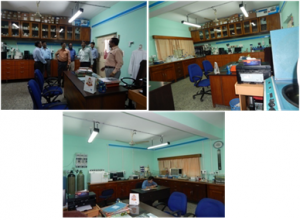 |
| Micro Nutrient Lab | Animal Biotechnology Lab |
 |
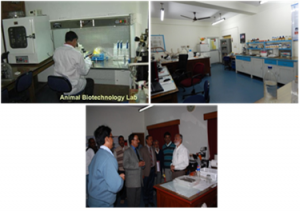 |
| Physiology & Reproduction Lab | Animal Breeding & Computer Lab |
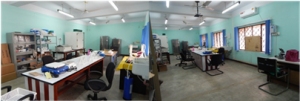 |
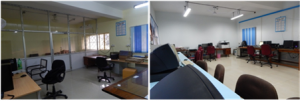 |
| Livestock Production & Management | Dairy Extension |
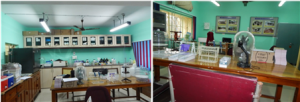 |
 |
| CONFERENCE ROOM | |
 |
On-Going Research Projects
| S. No | Project Title | Project Investigator | Duration |
| Institute Projects | |||
| 1. | Dietary manipulation of rumen fermentation using tree leaves of north eastern India for improving growth performance in calves. | A. Santra | April’14- March’16 |
| 2. | Comparative nutritional evaluation and utilization of some newer feed resources in dairy cattle ration. | A.Chatterjee | April’14- March’17 |
| 3. | Influence of some managemental practices on incidence of subclinical mastitis and quality milk production in dairy cows. | C.Bhakat | Dec’13-Dec.’17 |
| 4. | Effect of supplement of area specific mineral mixture (KALMIN) on productive and reproductive performance in dairy animals. | M.K.Ghosh | April’14- March’17 |
| 5. | Cryopreservation of cattle oocytes and their post thawing embryo development through in vitro techniques | S.K.Das | April’14- March’17 |
| 6. | Development of genetic model for improving the selection efficiency of crossbred cattle at ERS, NDRI, Kalyani | A. Mandal | April’14- March’17 |
| 7. | Application of Kisspeptin, a Noble GnRH Secretagogue for Augmentation of Reproduction in Crossbred cows. | M. Mondal | April’14- March’17 |
| 8. | Development of suitable protocol for preservation of Bengal Goat semen. | M. Karunakaran | April’14- March’17 |
| 9. | Dairying in sustainable livelihood among the rural farm family at Nadia district of West Bengal. | S. Garai | April’14- March’17 |
| Externally funded Projects | |||
| 10. | Application of Endocrine Biotechniques for induction of mother-neonate Bonding in Mithun (Bos frontalis | M. Mondal | 2009-Dec.’14 |
| 11. | Onset of puberty and Induction of Estrus: Role of Kisspeptin (kiss1) in bovine Species (Mithun and Cattle)” – DBT sponsored Twinning Programme | M. Mondal | Mar’14-March’17 |
| Tribal Sub Plan | |||
| 12. | Upliftment of socio-economic condition of Tribal people through Integrated Livestock Farming in north eastern hill region/eastern part of India. |
Academic Activities
- Diploma in Animal Husbandry and Dairying (DAHD): Started from 2014-15 academic sessions.
- Post Graduate Students (M. Sc. / M. V. Sc.): Allocated for dissertation works
| Course | 2010-11 | 2011-12 | 2012-13 | 2013-14 | 2014-15 | |||||
| M | F | M | F | M | F | M | F | M | F | |
| M.Sc / M.V. Sc. | 2 (ABT-1, LPM-1) |
– | 2 (AN-2) |
– | 3 (AN-2, LPM-1) |
– | 5 (AN-2, ABT-1, LPM-1, Econ-1) |
– | 3 (AN-2 AGB-1) |
2 (AN-1 AGB-1) |
Cattle Yard
The Cattle yard of the station maintains around 160 crossbred cattle. The cattle yard comprises of Calf shed, Heifer shed, Experimental animal shed, Milch animal shed, Milking Byre etc. which are being utilized for production, research as well as for hands on training, demonstration and orientation for the dairy farmers of the region on different aspects of scientific dairy farming.
Computer Section
The computer center maintains the database of cattle yard as well as the experimental data of various research projects. The institute has Internet connectivity (512 kbps) from ERNET through VSAT, which is useful for searching literature and references. The facility is used by Scientists, Students and staff of the Regional Station.
Library
The library contains 1521 books, 3458 volumes of bound journals and other periodicals in the field of Dairying. Besides, Annual Reports of different Institutes and proceedings of various workshops and seminars are also available for reference. Presently 8 journals are subscribed.
Fodder Farm
Forage section is engaged in cultivation of quality fodder crops (including organic fodder) in about 30 hectare areas. The section manages harvesting and provides chaffed or unchaffed fodder crops to the farm animals. Besides cultivation of fodder crops, the section also has a mini workshop for regular servicing of agricultural machineries including tractors, chaff cutter etc. There is also an agri-meteorological observatory from where regular meteorological observations are recorded. There are about 700 plants of teak, sissam, etc. growing around the institute premises. Besides, there is a fodder herbarium for training and demonstration purpose. Recently, a feed milling plant is being installed at this campus for preparing the experimental concentrate formulations.
Guest house
The station has a small Guest House having three furnished air conditioned rooms with internet facility.
Hostels
Presently four ‘A Type’, partially B & C-type residential Quarters have been converted to Student Hostel for Boys and one D type quarter for girls.
Sports
Some indoor sports facilities have been developed such as badminton, table tennis, carom, and volleyball as outdoor game.
Extensions Activities
The eastern regional station regularly conducts various types of training programmes in different areas of dairy production. Training programmes on “Scientific Dairy Farming” for 15 days, “Artificial Insemination” for 42 days and “Animal Nutrition & Fodder Production” for one week for educated unemployed rural youth/progressive farmers are being organised every quarter for educating the rural mass on dairying. Field visits and orientation programmes are also organised for the farmers of Dairy Cooperative Societies and NGOs on request. Sponsored Training programmes are also organized in ERS, Kalyani campus.
